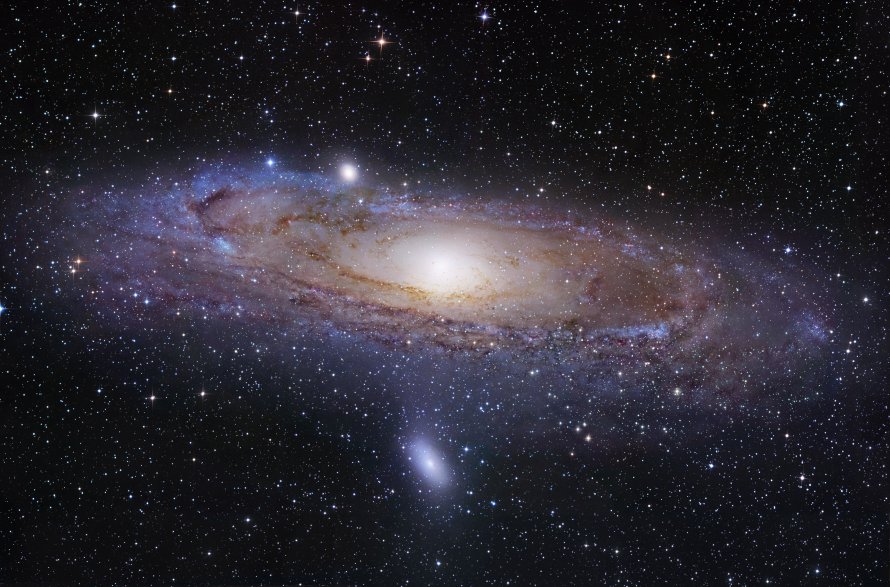M31 (NGC 224) - Andromeda Galaxy
Messier 31 (NGC 224), also known as the Andromeda Galaxy, is a spiral galaxy located in the constellation Andromeda in the Local Group of galaxies. M31 is 2500000 light years away from Earth.
M31 is best viewed during winter, is magnitude 3.4, and can be viewed with naked eye. M31 is 3° x 1° in apparent size. For reference, the full moon is 30'.
Observing difficulty: Easiest
- Name:
- Andromeda Galaxy
- Type:
- spiral galaxy
- Constellation:
- Andromeda
- NGC or IC:
- NGC 224
- Magnitude:
- 3.4
- Viewing:
- naked eye
- Size:
- 3° x 1°
- Distance (light years):
- 2500000 LY
- RA:
- 0h 42.8m
- Dec:
- 41 16'
- Season:
- winter
- Galaxy group:
- Local Group
- Messier Marathon #:
- 4
- Contains:
- 1 trillion stars
* The naked eye can see up to magnitude ~7-8 objects under ideal dark sky conditions.
Exploring the Andromeda Galaxy
Often hailed as the crown jewel of the Messier objects, Messier 31, better known as the Andromeda Galaxy, is the most distant object visible to the unaided eye. It's a captivating object, drawing both amateur astronomers and professionals towards its spiral arms and intriguing past. This article will explore the discovery, properties, and observation details of this majestic extragalactic neighbor.
Discovery and Historical Significance
The Andromeda Galaxy has been observed by humans for millennia, with the first recorded observation dating back to 964 AD by the Persian astronomer, Al-Sufi. However, it was Charles Messier who cataloged it as M31 in 1764, mistaking it for a nebula. It wasn't until Edwin Hubble's observations in 1923 that M31 was confirmed to be a galaxy external to our own, forever altering our understanding of the Universe's vastness.
Physical Characteristics and Magnitude
At approximately 2.537 million light-years away, the Andromeda Galaxy is our closest spiral galaxy neighbor. With an apparent magnitude of 3.4, it's bright enough to be seen by the naked eye in clear, dark skies. It spans about 3 degrees across the sky, which is approximately six times the diameter of the full moon, although its outer extremities are much fainter and harder to detect. M31, with its companion galaxies M32 and M110, presents a fascinating system for studying galactic structure and evolution.
Astronomical Significance
M31 is virtually a twin of our Milky Way in terms of structure, being a barred spiral galaxy. However, it's significantly larger, with an estimated one trillion stars compared to the Milky Way's 250-400 billion. M31 provides a unique perspective to astronomers for understanding large spiral galaxies' structures and evolution, as it allows an external view we can't get for our own galaxy. Notably, M31 is blue-shifted, meaning it's moving towards the Milky Way, and is expected to collide with us in about 4 billion years, providing a significant future event for astronomers to predict and model.
Finding and Viewing M31
Located in the constellation Andromeda, M31 can be found by star-hopping from the constellation Cassiopeia or the Great Square of Pegasus. Once located, M31 can be seen as a faint smudge of light with the naked eye under good conditions. With binoculars or a small telescope, the bright core becomes visible, and with larger telescopes, some of the dark dust lanes and bright star clusters can begin to be resolved. The overall view, however, is often less detailed than photographs might suggest, due to the galaxy's large apparent size and relatively low surface brightness.



